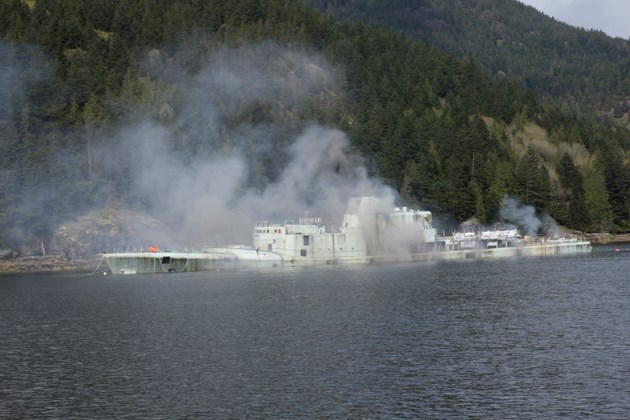Seven years since its original purchase, the HMCS Annapolis was finally sunk off the coast of Gambier Island in Halkett Bay Provincial Marine Park on Saturday April 4.
A couple hundred spectators showed up in chartered boats and personal crafts to watch the sinking first hand, while hundreds more from all around the world tuned in online to see the ship go down.
“I feel like I’ve got 3,000 tonnes of weight off my shoulders,” Howard Robins, president of the Artificial Reef Society of BC (ARSBC), told Coast Reporter. “It’s down, it’s over. The project is finished. It’s been delivered to the province and we’re very pleased. It’s a successful project — number eight — and now she's going to be our living laboratory of study and research.”
The ARSBC has been working to sink the Annapolis in Halkett Bay since its purchase in 2008. A drop in the value of recycled metal, changes to federal government regulations, and environmental concerns over the toxicity of the paint on the Annapolis have all stymied the project along the way.
But the ship is finally at the bottom of the ocean, and according to Robins, the sinking was flawless.
“It flooded from the bottom up, as we intended,” Robins said. “As that water kept moving upward, spreading out throughout the ship, she went down in a very even and stately manner and landed squarely on her keel. She’s completely upright underwater right now at the prescribed depth.”
Linear shaped charges, roughly one-meter square in perimeter, were placed inside the hull of the vessel, six on each side of the ship in various locations. Once detonated, the square plates fell back into the hull allowing water to fill the ship very quickly.
“It’s almost like a 10,000 degree burn right through the metal,” Robins explained. “And it [is] a clean cut, sufficient enough that you could likely put the plate right back on it and weld it right back up again.”
The initial blasts — which were quite loud — were actually explosions from detonation cords and blasting caps that initiated the burn.
“Like lighting the fuse on a fire cracker,” Robins said.
The sunken Annapolis will be used for a few different purposes. Primarily, it will serve as an artificial reef for marine life to make a home out of. This marine life will be studied periodically by the ARSBC and documented on a website that is now being set up.
“This ship will provide dark recessed areas and act as a pinnacle, with cave-like settings suitable for rock fish species, notably yellow-eye, tiger and quillback,” Dr. Jeff Marliave, vice president of Marine Sciences at the Vancouver Aquarium said in a press release.
As of Monday, Robins reported that a few of the more curious fish in the area are already beginning to check it out. Over the coming weeks and months they will start to see more crustaceans and plant life making the Annapolis their home, he added.
Due to its close proximity Vancouver, the Annapolis can also be used for search and rescue and small submersible training.
As well it is expected to be a good tourism draw for recreational divers. This is the eighth ship sunk by the ARSBC and many of the people who turned out Saturday to watch the sinking were divers excited for another wreck to explore.
On Sunday, professional divers went down to check that everything had gone according to plan.
“They’re very satisfied that the ship is in great condition,” Robins said. “So at this point we have declared the wreck open for recreational diving.”
For more stories from the Coast Reporter, click here.



